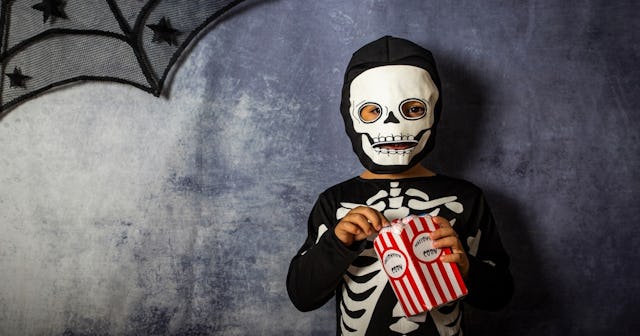Make No Bones About It, These Skeleton Coloring Pages Are Tons Of Fun

With Oct. 31 just around the corner, skeletons are popping up everywhere this time of year. In fact, skeleton decorations are the third most popular spooky decor next to witches and jack-o’-lanterns. And no doubt your child is bone-fied ready for Halloween, which is why our collection of free skeleton coloring pages is the perfect way to spend a chilly fall afternoon in preparation for the big night. Whether your little one finds skeletons humerus or they have a curiosity about scientific things, these pages pair well with a haunted house visit or learning more about the human body together.
It’s funny how even though skeletons are most often associated with the dead, the bones inside our bodies are alive — changing and growing. Larger bones such as the hips are hollow and contain a thick jellylike substance called marrow, and its job is to make blood cells. These blood cells carry oxygen throughout your body, as well as white blood cells, which seek and destroy invaders such as bacteria and viruses. Not so scary after all, right?
Whatever comes to mind when you see these hip bones, our free skeleton coloring pages are perfect for any age. Bonus: With each coloring page, we’ve included some spooky-yet-cool facts about skeletons to share with your kids that will surely tickle their funny bones. Later, you can check out our other Halloween-inspired coloring pages, including pumpkin coloring pages, vampire coloring pages, ghost coloring pages, and bat coloring pages.
Free Printable Skeleton Coloring Pages
Skeleton Page No. 1
Babies might look squishy, but a baby’s body has about 300 bones at birth, which eventually fuse (grow together) to form the 206 bones that adults have. By the time you are about 25, this process will be complete.
Skeleton Page No. 2
So, just where are these bones? Well, the spinal column has a total of 26 bones, while the ribs hold 24 bones. Arms and legs combined have a total of 120 bones. Your head? It has 29 bones — the cranium and mandible are the main bones in the skull, which each consist of several bones. And believe it or not, six bones form the ears.
Skeleton Page No. 3
The largest bone in the whole skeleton is called the femur, which is in your thigh. The smallest bones are inside your ear: the hammer (malleus), stirrup (stapes), and anvil (incus).
Skeleton Page No. 4
The “funny bone” got its nickname because of that funny feeling you get after you hit it (which isn’t all that funny). But your funny bone isn’t actually a bone at all — it’s a nerve running down your elbow called the ulnar nerve.
Skeleton Page No. 5
Some of the most famous skeletons in pop culture include Jack Skellington from The Nightmare Before Christmas, Skeletor from He-Man, and Bonejangles from Corpse Bride.
Skeleton Page No. 6
The skeleton has been associated with Halloween for thousands of years, dating back to the celebration of Samhain, in which ancient pagan Celtic people honored the gods and goddesses of the harvest. Not surprisingly, the festivities leaned heavily on superstition, including the Celtic people’s belief that the skull was the house of the soul.
Skeleton Page No. 7
Día de los Muertos, or Day of the Dead, is a celebration of life and death held on November 1 and 2. While the two-day holiday originated in Mexico, it is celebrated all over Latin America with colorful calaveras (skulls) and calacas (skeletons).
Skeleton Page No. 8
Because the film was stop-motion, it took animators about three years to complete The Nightmare Before Christmas. The film got its inspiration from a poem written by Tim Burton when he was an animator for Disney. He would later serve as the producer of the film.
Skeleton Page No. 9
Although bones are super strong, they do lose strength and density over time. Eating calcium-rich foods like dairy products, broccoli, and some fish — as well as incorporating weight-bearing exercise into your life — will help keep bones strong.
Skeleton Page No. 10
Why do we have bones anyway? They give our muscles (and internal organs) support and protection while allowing our bodies to move. They also store essential minerals and help produce blood cells. And here’s another scientific fact about bones: They are constantly rebuilding themselves with collagen. So, technically, every seven years or so, you will have a new skeleton.
Click here to print all of the skeleton coloring pages at once!
This article was originally published on